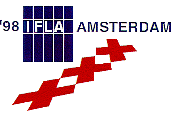
As of 22 April 2009 this website is 'frozen' in time — see the current IFLA websites
This old website and all of its content will stay on as archive – http://archive.ifla.org

As of 22 April 2009 this website is 'frozen' in time — see the current IFLA websites
This old website and all of its content will stay on as archive – http://archive.ifla.org





In area 1 (Title and statement of responsibility), there was one substantive change, undoubtedly the most notable and controversial change in the ISBD(ER). This was the replacement of the GMD "Computer file" in the ISBD(CF) with "Electronic resource." This change was made only after world-wide review of the revised text, which indicated dissatisfaction with the original GMD. The ISBD(CF) Review Group considered a number of possible terms, but gave its greatest support to "electronic resource."
Principal changes in area 2 (Edition) affected stipulation 2.1 (Edition statement). These included clarifying the concept of "edition," reconsidering the issue of single/separate records,
particularly as they related to remote access items; providing for multiple edition statements associated with interactive multimedia; and treating remote access items which were subject
to frequent or continuous updating. In the latter case, an instruction was added in 2.1 to omit edition statements altogether in this area and, instead, to give them in an appropriate note, e.g.:
The most extensive revision in the ISBD(CF) occurred in conjunction with area 3 (Type and extent of resource). Stipulation 3.1 (Type of resource) was completely reworked to improve its usefulness for describing the variety of remote access material available on the networks. This resulted in the introduction of 27 new resource designations that were added to the original list of three designations in the ISBD(CF). These 30 terms represented three levels of specificity, starting with the original three generic designations at the first or top level, followed by specific designations representing these categories listed at the second or middle level, with these, in turn, being represented by more specific terms listed at the third level, e.g.:
Designations at any one of these three levels can be used as desired. In the case of data and program combinations, specific designations can be combined, e.g.:
Area 4 (Publication, distribution, etc.) in the ISBD(CF) was reviewed to assess the treatment for cataloging remote access items. It was determined that all computer files, both remote and local, were treated as being "published." This treatment of remote access items, in particular, was found to conform with OCLC's Guidelines for Bibliographic Description of Internet Resources (OCLC, 1995), which represented the viewpoint of catalogers contributing bibliographic records for remote access titles to its world online catalog. To underscore this treatment in the ISBD(ER), text was inserted in the "Introductory note" as well as in stipulations 0.1.1 and 0.2. Another issue of concern was the treatment of specific date information (e.g., month, day, year) found in dynamic remote access resources (e.g., online services). It was decided to add text in stipulation 4.4.1 to allow for giving this information in a note, e.g.:
Finally, a new stipulation, 4.4.7.1, was added in the ISBD(ER) to accommodate resources with multiple copyright dates (e.g., interactive multimedia). In these cases, the latest copyright date is to be given when no one date is found that applies to the resource as a whole.
Area 5 (Physical description) in the ISBD(CF) was the focus of considerable revision. The "Introductory note" was reworked to address edition issues associated with physical carriers of different types and sizes, and in different formats. In all these situations, ISBD(ER) provides the choice of either making separate or single record bibliographic descriptions. In stipulation 5.1.1 (Specific material designation (SMD)), the spelling "disc" was introduced to describe optical carriers, with the confinement of "disk" to describe magnetic carriers, a decision that was influenced by the adoption of these spellings in ALA's Guidelines
for Bibliographic Description of Interactive Multimedia (ALA, 1994). Further, in the case of optical carriers, provision was made in stipulation 5.1.3 to identify in parentheses one of three
particular disc formats, if desired--CD-I, CD-ROM, or Photo CD:
Finally, in stipulation 5.3.1 (Dimensions), an option was added to express the dimensions of physical carriers in inches rather than in centimeters.
Principal changes in area 7 (Notes) affected several stipulations. Text was added in the "Contents" to have the "Mode of access" note, along with the "System requirements" note, precede all other notes. Both notes were made mandatory, with the "System requirements" note (7.5.1) being used to describe local access items, and the "Mode of access" note (7.5.2) being used to describe remote access items. In the case of local access items with two or more different physical carriers, each with its own system features, provision was made for agencies to make either separate "System requirements" notes for each system, or a single note for all the carriers. Text was added in stipulation 7.2.2 (Bibliographic history) to provide for indicating the frequently changing contents of dynamic remote access items, referenced earlier. Stipulation 7.9 (Resource described) was revised to indicate the edition on which the description is based, also referenced earlier.
Principal changes affected three appendices in the ISBD(CF): Appendix B with the first example of a bi-directional record; Appendix C with the definitions of the GMD, SMDs, and resource designations; and Appendix E with 14 new examples. Finally, the "Index" in the ISBD(CF) was greatly expanded, which resulted in an increase in entries that represented approximately 150%.